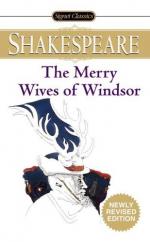|
This section contains 4,016 words (approx. 14 pages at 300 words per page) |

|
SOURCE: "Falstaff in Windsor Forest: Villain or Victim?" in Shakespeare Quarterly, Vol. XXVI, No. 1, Winter, 1975, pp. 8-15.
In the essay below, Roberts examines the last scene of The Merry Wives of Windsor where Falstaff is disguised as Herne the Hunter, and concludes from this scene that the fat knight is meant to be a scapegoat whose pathetic ridiculousness serves to unite the various characters of the play.
Falstaff is like a Rorschach test: we can analyze the personality of the perceiver by his reactions to the figure. But unlike the famous ink blots, the figure of Falstaff is the result of conscious and sustained artistic creation. A subtle and complex character with some clearly fixed features emerges from Shakespeare's portrait of the man in three separate plays. We may argue ad infinitum about Shakespeare's original intentions and about the interrelation of the three plays, but discussion of this...
|
This section contains 4,016 words (approx. 14 pages at 300 words per page) |

|


